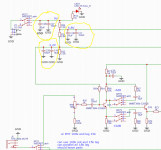Hi there, I have a circuit with a voltage divider that divides the supply voltage with 3 resistors. For biasing the bases of transistors, I've done this before to have a lower voltage bias for simple amplifiers, and higher voltage bias near vcc/2 for emitter followers.
I have always used them in op amp circuits, but not usually with transistor circuits.
Should I be using them in BJT circuits like emitter followers and amplifiers? Please see the attached figure.
If so, is this attachment I have included the right or best method? I can think of several different arrangements. Like walking them down the resistor divider from resistor to resistor or hooking all capacitors to ground. Also, are the capacitors shown connected to vcc 9v needed? Sometimes I see these caps omitted.
I know the size of the capacitors in the schematic should be increased, but is the circuit arrangement correct?
Thank you very much for helping.
I have always used them in op amp circuits, but not usually with transistor circuits.
Should I be using them in BJT circuits like emitter followers and amplifiers? Please see the attached figure.
If so, is this attachment I have included the right or best method? I can think of several different arrangements. Like walking them down the resistor divider from resistor to resistor or hooking all capacitors to ground. Also, are the capacitors shown connected to vcc 9v needed? Sometimes I see these caps omitted.
I know the size of the capacitors in the schematic should be increased, but is the circuit arrangement correct?
Thank you very much for helping.
Attachments
Yes, they are needed. The smaller capacitors that are in parallel with the larger capacitors often are omitted,
and they may be unnecessary here as well. I would make C26 more like 100uF, but the others are ok.
and they may be unnecessary here as well. I would make C26 more like 100uF, but the others are ok.
Last edited:
And do not cascade them but send each one straight to ground.
Op amp or discrete does not matter, all are gain stages, and clean, low impedance reference voltages always help.
Op amp or discrete does not matter, all are gain stages, and clean, low impedance reference voltages always help.
However do note that in ac analysis, the capacitor is considered a short circuit to ground. So you actually need a big resistor between that and the input that you are biasing...
Also take note that the capacitor introduces a RC constant to your bias, so the bias voltage will take some time to reach there and it can cause a boop during turn on.
Oon
Also take note that the capacitor introduces a RC constant to your bias, so the bias voltage will take some time to reach there and it can cause a boop during turn on.
Oon
